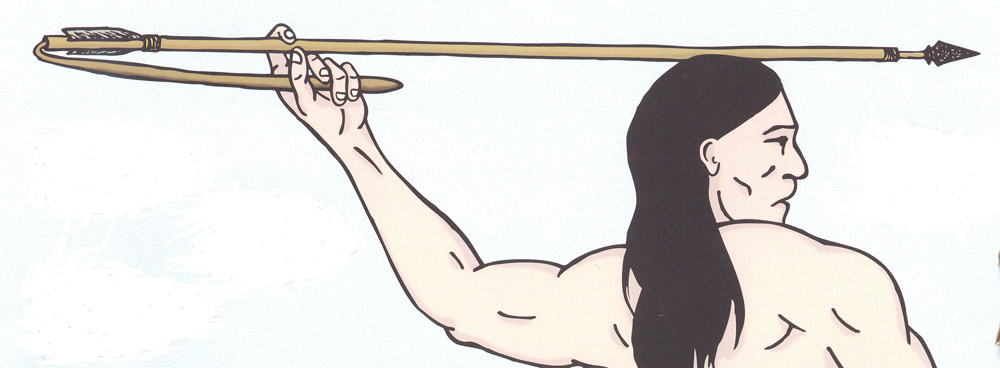Hunting for food in the late ice age and for many thousands of years after, was not as simple as throwing a spear at a bison or a mammoth. Spears and darts thrown with great power and accuracy at a mammoth, might only slow the animal down for a while. Hunters had to wait for the animal to drop or die. In the meantime, other predators might attack the wounded animal. Successful hunting involved a complex of social organization and proper technique that required careful thought and advance planning.
The earliest People probably hunted west of the Missouri River, but as the land to the east became drier and the largest beasts (megafauna) such as mammoths had become extinct, hunters moved eastward. People settled near grassy open areas near lakes and rivers. Game (animals they hunted) also favored that environment. People often “ambushed” bison and other game animals at springs and small lakes when the animals came to drink. (See Image 1.)
Over thousands of years, hunters developed a variety of effective techniques for killing large game animals. Archaeologists have found places where People killed more than 100 bison. In order to make a kill of this size, People worked together with a plan to drive bison into small canyons or corrals that the animals could not get out of. Then, People closed in on the trapped animals and killed them. This place was called an impoundment and the process was called pounding. They usually processed the meat and hides at the same place. People might have made this sort of mass bison slaughter early in the spring and again in the late fall.

Sometimes people drove bison toward a cliff. This process took careful organization. People hid in brush or behind rocks along a trail. Someone started the herd running in the direction of the trail. As the herd passed by, the hidden hunters jumped up and scared the animals to keep them running fast. As the herd proceeded along the trail, running faster and faster, the trail narrowed and pointed the herd toward a cliff. Unable to stop in time, the animals tumbled over the cliff. Many were too badly injured to get up and run on. Hunters waiting at the base of the cliff moved in and killed the injured animals. Dogs were sometimes used as pack animals to carry the meat and hides back to the People’s campsite.
People also ate deer, pronghorns, rabbits, prairie dogs, fish, mussels, birds, bears, and wolves. However, People of many cultures preferred bison because they provided not only great quantities of meat, but also hides, bones, and other organs. The animals they killed for food also provided bone to make tools, hides for clothing and shelter (from hides), and other materials such as bladders that could be used to hold water. Bison HidesBison hides provided the largest piece of material for making clothing and shelter for the People. Hides were stretched on the ground for scraping and tanning. The hide preparer used bone or stone scrapers with sharp edges to remove the hair from the outside of the hide and the fat from the inside of the hide. Then, the preparer rubbed the brains of the animals into the hide. Mashing the brains released tannic acid and other chemicals that preserved the hide and softened it. The hide was then soaked in water and scraped once more to remove the last of the hair. Then the hide was smoked over a fire. The smoke sealed the hide against moisture. It is likely that hide tanning was not practiced by the earliest People, but came into use much later in this time period.
Hunters were also gatherers. In the proper season, the People knew where to find and harvest acorns and other seeds, berries and other fruits, green leafy plants, and roots. Plants provided vitamins that meat did not contain and helped the People to maintain their health. The People probably dried berries and roots to keep for use in winter and early spring.
Methods of hunting big game remained about the same until around 600 A.D. when bow and arrow technology made hunting more efficient. People continued to depend on bison and other animals for their main food source until well into the 19th century when the great herds of bison nearly disappeared from North America.
Why is this important? The People who lived on the northern Great Plains in the ancient past were hunters and gatherers. Hunting determined how they lived and how they made their tools. They organized their families and communities around hunting.
They learned how to kill, cook, and preserve meat. As hunters, they had to adapt when the climate changed and the animal life changed, too. They developed new tools that were more efficient for hunting large and small game. By studying how ancient People hunted, we know that they lived in well-organized communities and adapted to changes in animal behavior, climate, and technologies.


